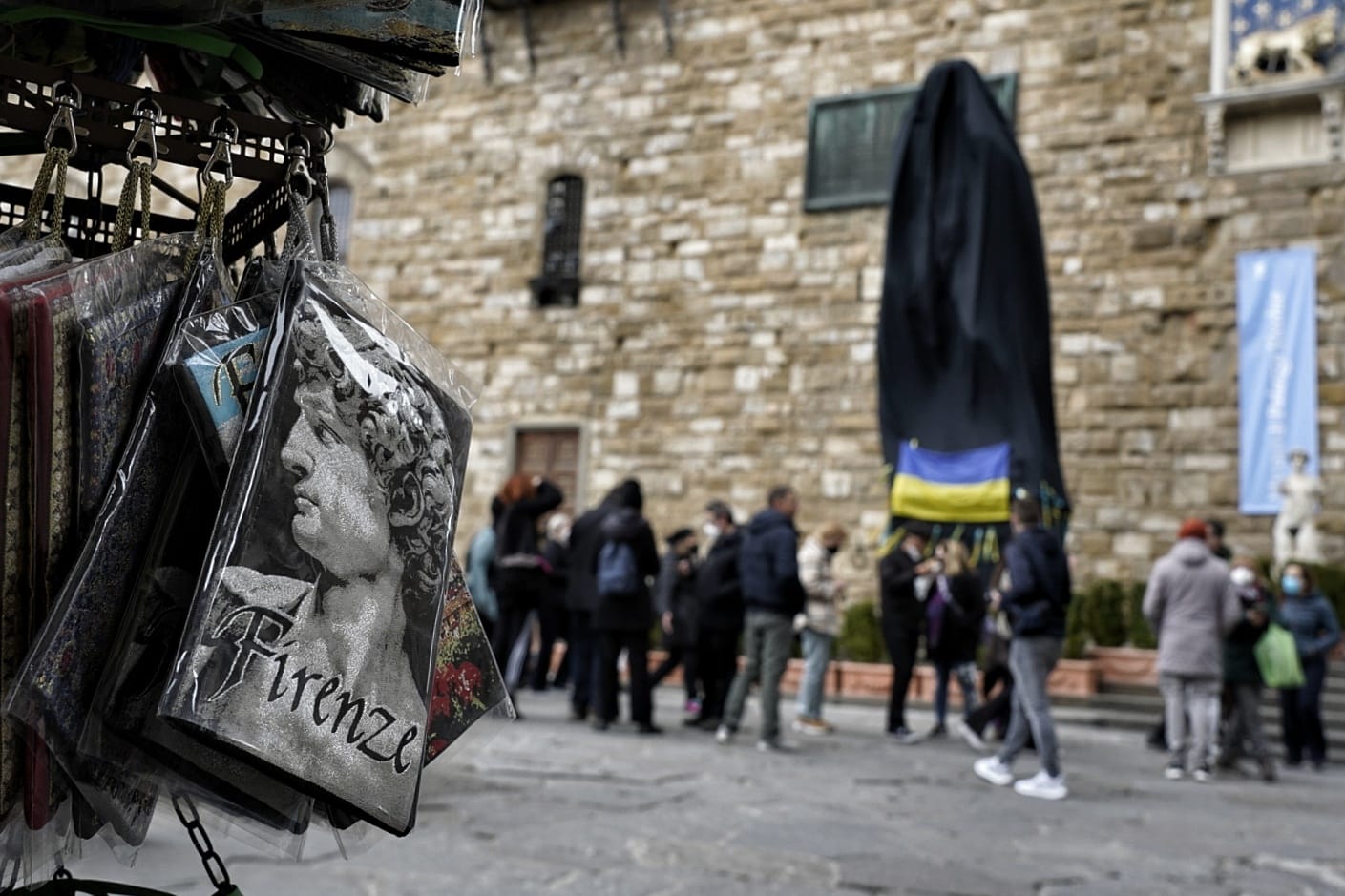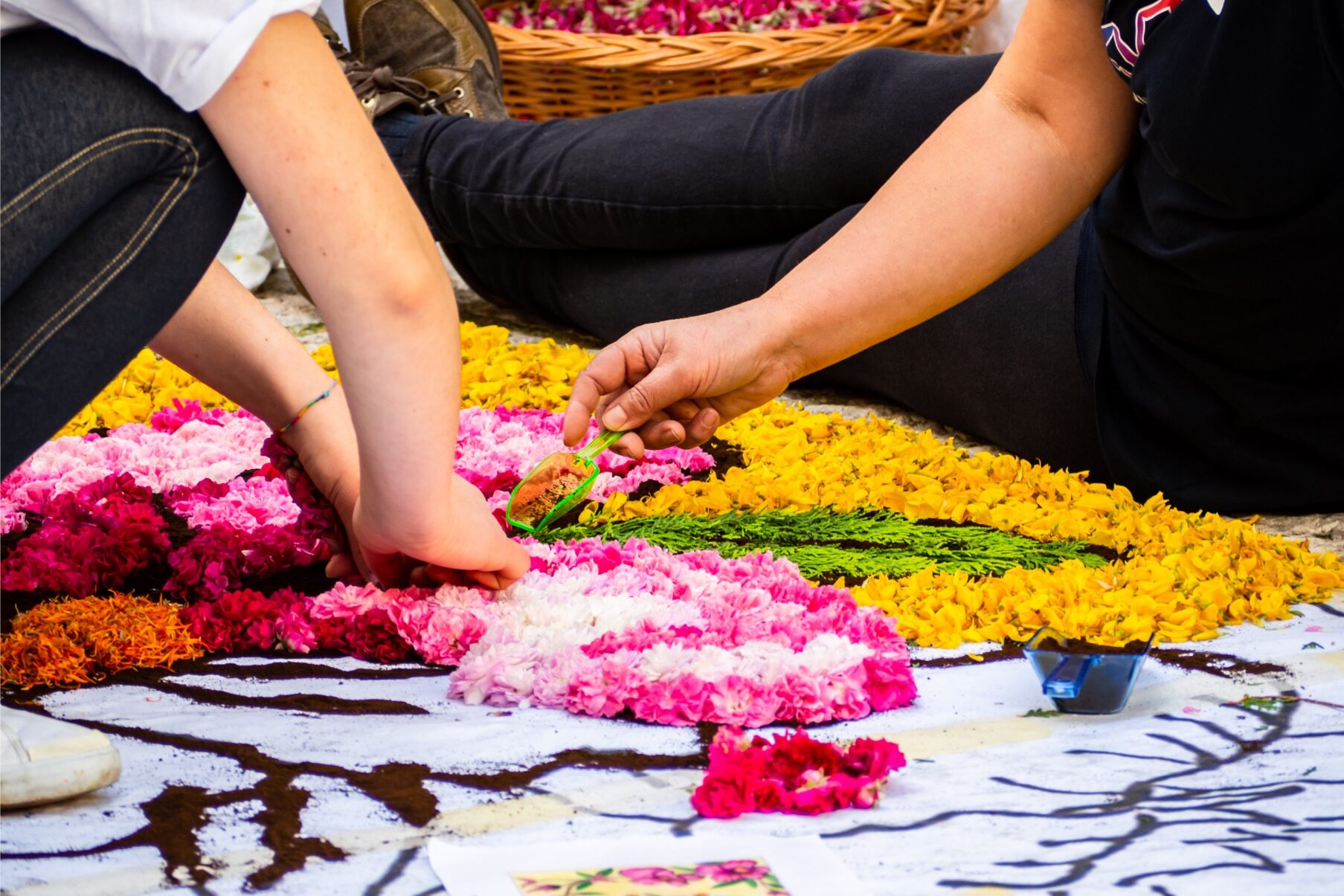Art wants to stir our emotions and our thoughts, to provoke in us a reaction. It wants to offer new points of view and suggest original ways to interpret what’s around us. One can condemn or can dream of a whole new world. One can paint a Guernica against the violence of war, just like Picasso did, or go for magical art like the Surrealists, who found refuge in imaginary worlds because rationality and logic only led to the horrors of World War Two. You can even give up the dream of a lifetime, just like Jacopo Tissi – pride and joy of Italian ballet – did, by giving up his place as the principal dancer at the Bolshoi in Moscow, because “no war can ever be justified.”
But we can also use places, monuments, or ancient symbols to deliver unusual messages. One may not like a David covered in a black sheet and in mourning, but reinterpreting art is interesting.
In 1919 Marcel Duchamp gave Leonardo’s Mona Lisa a mustache. An offense? Not really. Dadaism broke rules on purpose to carry out a conceptual revolution that replaced official languages with total expressive freedom. Nothing better, for the French-naturalized-American artist, than using the most iconic image of western art for such a desecrating act.
Christo and Jeanne-Claude, a famous artistic duo, in 1974 wrapped a large section of the Aurelian Walls in Rome, built between 270 and 275 AD to protect the capital from enemies, with polypropylene. The installation, called “The Wall, Wrapped Roman Wall,” wasn’t really understood. Most Romans thought local authorities were carrying out restoration works. They didn’t understand, but it was an incredible provocation: it wanted to make people aware. The act of “hiding” was key to the artists’ creative philosophy: because the object was somehow taken away because it was hidden, its presence was at once exalted. Its absence made it desirable. The object was there and, once hidden, it became paradoxically more prominent: the void it left, its absence made it blatant.
It is interesting, then, to wonder about the messages associated with art, about its ability to provoke. But it’s also curious to read symbols and monuments anew, in a modern key, as well as delivering modern meaning through them. When we see the façade of a public building illuminated with the colors of a flag, or of a social event, we’re not only witnessing a powerful communication strategy, but also an artistic provocation.
In the past days, Sting showed us the importance of reinterpreting art. “I’ve rarely sung this song in the last years because I didn’t think it would have been relevant again.” But, as if clocks turned back, his “Russians” turned into a contemporary piece that reminds us all we must stop the war now. The British singer had written it during the Cold War, in 1985, in a world scared of the atomic bomb. But many analogies, including the dangerous advancing of the Doomsday Clock, which is now only 100 seconds away from its “midnight,” make us believe it’s been just written. That’s why it’s important to propose it again, highlighting its message and its call for peace. Because destruction brings only more destruction, while we must return to speak the language of humanity, which we all share.
The case of “Bella Ciao,” the Italian popular song that has become, throughout the years, the symbol of Italian “Resistenza” (and which is still controversial today) is just as interesting because it turned into an anthem of freedom and resistance all over the world. It isn’t the first time that, even if exported and decontextualized, reinterpreted and adapted to events that are from those which inspired it originally, it managed to preserve its revolutionary power, its combative and idealistic spirit.
Popular Ukrainian folk singer Khrystyna Soloviy covered it, adapting its lyrics and dedicating it to “all of our armed forces, to our heroes and to all those who are fighting for our country right now.” The video received more than 66.000 views on Youtube, in just 24 hours.
While this new war shakes our conscience, lengthening the tragic list of all the conflicts weighing on our souls that we have not been able to avoid with diplomacy – neither on this or the other side of the ocean – it is very useful to reflect on the messages that art and music can deliver.
Just like it was useful to sing from our balconies during the pandemic. We were looking for strength together, we wanted that human contact the virus denied us, we wanted to help one another. We wanted to feel close to each other and overcome our fears, pain, anxiety, and anguish together: feelings we still can’t pack away in a box in the attic. We were defending our humanity from all that could put it at risk. This is exactly what we should do now, for this war.
Provocare emozioni con l’arte. Stimolare pensieri e reazioni. Indurre sguardi nuovi, suggerire inedite chiavi di lettura. Si può denunciare o sognare un mondo nuovo. Dipingere una Guernica contro la violenza della guerra come fece Picasso o puntare sull’arte magica come i Surrealisti che si rifugiarono in mondi immaginari visto che razionalità e logica non avevano portato a nulla di buono ma agli orrori del secondo conflitto mondiale. Si può persino lasciare il sogno di una vita, come l’ambitissimo posto da primo ballerino del teatro Bolshoi di Mosca come ha fatto Jacopo Tissi, orgoglio italiano della danza nel mondo, perché “nessuna guerra può essere giustificata, mai”.
Ma anche usare luoghi, monumenti o simboli antichi per veicolare messaggi insoliti. Si può non condividere un David coperto e in lutto ma è interessante reinterpretare le opere d’arte.
Nel 1919 Marcel Duchamp mise i baffi alla Gioconda di Leonardo da Vinci. Un affronto? Non proprio. Il Dadaismo infrangeva di proposito le regole per portare avanti una rivoluzione concettuale: totale libertà espressiva per sostituire i linguaggi ufficiali. Niente di meglio dunque, per l’artista francese poi naturalizzato statunitense, che usare non solo un’immagine accademica ma l’icona artistica per eccellenza, come il capolavoro leonardiano, per compiere un’azione dissacrante.
Il duo artistico Christo e Jeanne-Claude invece, nel 1974 avvolse nel polipropilene un tratto lungo 250 metri delle Mura Aureliane di Roma erette tra il 270 e il 275 per difendere la capitale dell’impero da attacchi nemici. “The Wall, Wrapped Roman Wall” come si chiamava l’istallazione, non fu nemmeno compresa. Molti cittadini romani pensarono fosse un cantiere, supposero che il Comune stesse semplicemente portando avanti dei lavori di restauro alle antiche mura. Non capirono affatto ma la provocazione era sorprendente: aspirava a rendere consapevoli. Il celare era un fattore scatenante della filosofia creativa: proprio perché sottratto, l’oggetto veniva risaltato nella presenza. L’assenza, lo rendeva desiderabile, anelato. Il soggetto era lì, ma una volta oscurato paradossalmente lo si esaltava: il vuoto, la mancanza, lo rendeva evidente.
Interessante insomma, interrogarsi sui messaggi delle opere d’arte, sulla loro capacità di provocare ma curioso è anche rileggere simboli e monumenti in chiave attuale o anche veicolare significati contemporanei attraverso essi. Quando vediamo la facciata di un palazzo pubblico illuminarsi con i colori di una bandiera o di un evento sociale, non c’è solo un’efficace strategia comunicativa ma anche una provocazione artistica.
Nei giorni scorsi, Sting ha suggerito l’importanza delle riletture dei classici. “Ho cantato questa canzone raramente negli ultimi anni perché non pensavo che sarebbe stata di nuovo rilevante” e invece, come se gli orologi fossero tornati indietro, la sua “Russians” è suonata così attuale, così necessaria a ricordarci che bisogna fermare immediatamente la guerra. Il cantante britannico l’aveva scritta durante la guerra fredda, nel 1985, in un mondo spaventato dalla bomba atomica. Ma molte analogie, compreso il pericoloso avanzamento del “Doomsday Clock” arrivato a 100 secondi dalla mezzanotte, l’hanno fatta sembrare appena scritta. Di qui l’importanza di riproporla, rilanciandone il messaggio e l’appello alla pace. Perché la distruzione porta solo alla distruzione mentre bisogna tornare a parlare la lingua della comune umanità.
E’ altrettanto interessante notare come “Bella Ciao”, il canto popolare diventato negli anni il simbolo della lotta partigiana italiana (che tante contestazioni ancora oggi solleva), sia diventata un inno alla libertà e alla resistenza nel mondo. Non è la prima volta che pur se esportato, decontestualizzato, reinterpretato e adattato ad accadimenti ben lontani dalle origini, conservi la sua forza rivoluzionaria, il suo spirito combattente e ideale.
La popolare cantante folk ucraina Khrystyna Soloviy ne ha fatto una cover, rieditando il testo e dedicandolo “a tutte le forze armate, ai nostri eroi e a tutti coloro che in questo momento combattono per la propria terra”. Su Youtube in appena 24 ore ha ottenuto oltre 66mila visualizzazioni.
Mentre questa nuova guerra scuote le coscienze e allunga la lista tragica dei conflitti che abbiamo sulle coscienze e che non siamo riusciti ad evitare con la diplomazia, né da un lato né dall’altro dell’oceano, riflettere sull’arte e la musica e sui messaggi che possono veicolare, serve tanto.
Come è servito cantare dai balconi italiani durante la pandemia. Si cercava insieme coraggio, la socialità vietata dal virus, ci si dava una mano, tentando di sentirsi vicini per superare le paure, il dolore, l’ansia, l’angoscia che ancora non possiamo chiudere dentro uno scatolone da mettere in soffitta. Si difendeva la nostra umanità da tutto quello che la mette in pericolo. La stessa cosa che dovremmo fare con questa guerra.






























